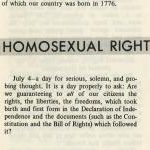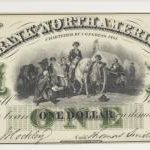Students who listen to this Grade 2 Core Knowledge History and Geography unit discover that Americans had a difficult task at hand after winning the Revolutionary War: they had to figure out a better way to govern themselves. Such leaders as James Madison, George Washington, Alexander Hamilton, and Benjamin Franklin traveled to Philadelphia to meet at the Constitutional Convention, with the goal of creating a new government. Students learn that the talks were held in secret in Independence Hall and that American leaders argued about many issues until they agreed to approve a new Constitution. They then hear that James Madison (whom we call the Father of the Constitution), along with John Jay and Alexander Hamilton, wrote the Federalist Papers to explain the document’s merits and to persuade the states to vote for it. Students find out that the states did finally approve the Constitution; that Madison wrote a Bill of Rights that was added to it; that the Constitution gives the American people the right to decide what the laws should be for our country; and that we can still amend it today.(5 lessons)
Founding Documents: Federalist and Anti-Federalist Papers Podcast
Ten days after the Constitution was signed at the Old Philadelphia State House, an anonymous op-ed appeared in the New York Journal. Signed by “”Cato,” it cautioned readers of the new Constitution to take it with a grain of salt. Even the wisest of men, it warned, can make mistakes. This launched a public debate that would last months, pitting pro-Constitution Federalists against Constitution-wary Anti-Federalists. It was a battle for ratification, and it resulted in a glimpse into the minds of our Framers – and a concession that would come to define American identity.
Our guides through the minds of the Federalists and Anti-Federalists are Claire Griffin and Cheryl Cook-Kallio.
This short episode includes a one-page Graphic Organizer for students to take notes on while listening, as well as discussion questions on the back side.
Founding Documents: The Constitution Podcast
After just six years under the Articles of Confederation, a committee of anxious delegates agreed to meet in Philadelphia to amend the government. The country was in an economic crisis — citizens couldn’t pay their debts, the government couldn’t really collect taxes, and rebellions were cropping up in states across the nation. The existing government had the potential to drive the country to ruin. So fifty-five men gathered to determine the shape of the new United States.
The document that emerged after that summer of debate was littered with masterful planning, strange ideas and unsavory concessions. The delegates decided they’d be pleased if this new government lasted fifty years. It has been our blueprint for over two centuries now. This is the story of how our Constitution came to be.
This short episode includes a one-page Graphic Organizer for students to take notes on while listening, as well as discussion questions on the back side.
The Constitutional Convention
In the summer of 1787, delegates gathered for a convention in Philadelphia, with the goal of revising the Articles of Confederation, the nation’s existing governing document, which wasn’t really working. Instead, they wrote a whole new document, which created a revolutionary form of government: the U.S. Constitution. Read more about the summer of 1787 in the National Constitution Center’s learning module.
Article VII: Ratification
After months of debate during the hot Philadelphia summer, on September 17, 1787, the Constitutional Convention finally adjourned and the new Constitution was signed, but it was not the law of the land yet. According to Article VII of the document, nine of 13 states would have to ratify (or approve) the new Constitution before it would officially replace the Articles of Confederation as our governing document.
The Constitutional Convention of 1787
In this unit, students will examine the roles that key American founders played in creating the Constitution, and the challenges they faced in the process. They will learn why many Americans in the 1780s believed that reforms to the Articles of Confederation were necessary, and the steps taken to authorize the 1787 Convention in Philadelphia. They will become familiar with the main issues that divided delegates at the Convention, particularly the questions of representation in Congress and the office of the presidency. Finally, they will see how a spirit of compromise, in the end, was necessary for the Convention to fulfill its task of improving the American political system.
Birth of American Democracy: Discourse, Debate and Compromise
In this exploration of American democracy students will follow the path to representative government by analyzing the tradition of discourse, debate, and compromise from Jamestown to Williamsburg and Philadelphia and finally to Washington. Students will determine the importance of debate and compromise for the development of a government by and for the people and also identify strategies for making their voices heard in government today. Free registration required to access lesson plan.
Celebrate Constitution Day By Exploring the 1787 Constitutional Convention Debates
Over the last several months, ConSource has detailed on our Blog the key debates that occurred during the Constitutional Convention in Philadelphia from May 25, 1787 to September 17, 1787. We hope you will join us in re-exploring the Constitutional Convention debates in honor of Constitution Day on September 17!
Teaching LGBT Rights

The history of equal rights for members of the LGBT community is something often overlooked in classroom curriculum. With the Supreme Court ruling that same-sex marriage is a constitutional right, it is important to look back at the men and women who fought for equality, especially right here in Philadelphia. Events, such as Reminder Day, are examples of how we can remember the contribution of men and women in the community who fought for their rights as citizens.
Economics through the Long History of America’s First Bank

Capitalism and the American nation have long been bedfellows; after all, they are both the children of eighteenth century Neo-Classical Liberalism. It is worth noting that both the “Declaration of Independence” and Adam Smith’s “Wealth of Nations” were presented to the public in the same fateful year of 1776. However, the America of Revolutionary days certainly was neither the financial nor business force that it is today, and understanding how the nation came to be so closely linked to capital is an important understanding.